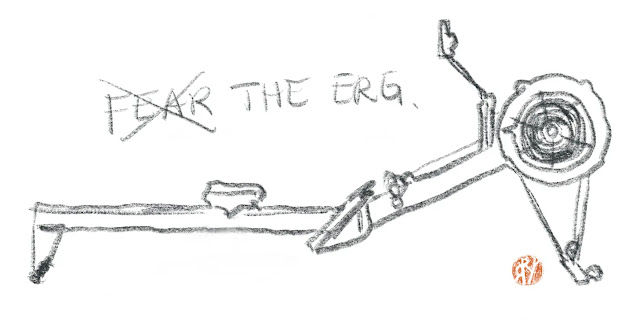Best Rowing Drills: Keeping It Moving with Ohio State's Andy Teitelbaum
 |
| Griggs Reservoir Boathouse (Photo: Madeline Davis) |
We're kicking off our second season of #BestRowingDrills with a look at making the transition from winter training to water time, thanks to Ohio State Women's Rowing.
"Erging is just cross-training," says three-time NCAA national champion head coach Andy Teitelbaum, who's Buckeyes debuted at no. 2 overall this season according to our Power Rankings. "It's a really good way to develop rowing fitness, but it's not rowing, any more than the 40-yard dash is a wide receiver runner a certain route," he elaborates.
"We pay attention to power application—I don't want them ingraining the wrong kind of muscle memory. So we'll pay attention to the way that they're spinning the wheel, and encourage them to use the big muscle groups instead of the little ones, but we really don't use drills on the erg. If we do at all, it will be to grab the handle and have an athlete suspend her weight [off the seat]." At times, they'll throw in a few strokes legs only to address a technical problem (see using small muscle groups, noted above), but that's really about it, according to Teitelbaum.
So how does that early transition to the water take place? Well, it certainly helps that the athletes at the back-to-back-to-back national champion program are already at a pretty high standard. Even still, Teitelbaum keeps it simple.
1: Front-End Focus
"Obviously, the biggest difference between rowing on land and rowing on the water is that there is a blade that needs to go into the water and come out of the water," he says with a laugh. "When we're on the water, we spend a lot of time trying to teach people to put the blade in the water at the proper point in the stroke cycle. So, we do a lot of placement drills, and a lot of placement-and-pull-through drills."Teitelbaum and his staff will mostly do this at full slide (with a full-slide pull through), unless there is a particular issue with an athlete, where she may need to address something in the upper body like, say, reducing the tension in the shoulders. "Generally, when you have them put the blade in the water and stop, the first thing they'll do is use their legs—they might use the upper body as the put the blade in the water, but once it's there, they'll generally put the pressure on the footboard." Makes sense, because given that they're at a complete stop, the load is heavy and the logical step is to use the bigger muscle groups.
"And we'll do variations of that—sometimes, without stopping the boat, we'll pause at the pivot [with arms and body forward], let the speed run out, and then try to place the blade as if the boat were sitting still, build for 10, and then pause again. We'll go for say, 1,000 meters, doing that in 10-stroke increments. It's the same idea, only without having to check the boat down, and sit still with your blades squared and buried, which turns it back into a balance drill."
And while Teitelbaum jokes that he's not huge on drills, he does say that he and the coaching staff will 'try everything' to get their athletes to put the blade in the water. "We'll row inside arm only; outside arm only; we'll do a slap drill; but I think, really, we always end up going back to placement and pull through," he says.
 |
| Teitelbaum and the Buckeyes' coaching staff at the NCAA championships, 2015 (Photo thanks to Madeline Davis) |
2: Pauses and Add-in Drills
"Pause drills are awesome—we'll pretty much always pause at the pivot, unless there's something else that we are specifically addressing." These also get mixed into other drills, as mentioned above, where it serves both as a checkpoint as well as a way to allow the boat to slow down, keeping the drills dynamic."We do a lot of add-in drills—and that's not really a drill in and of itself, so much as it's a wrinkle added to another drill. Like, for example, we could do placement and pull through, starting with a single pair, and then adding another pair, and another pair, etc., starting from slow, and going to fast: Can you execute the skill when the boat's hardly moving at all and is very heavy, and can you continue to execute as the boat picks up speed?"
3: Keep It Moving
"One thing I would say is, we drill a relatively small percentage of the time that we're actually rowing. If I can figure out a way to incorporate a drill without having to stop the boat, then I'll do that, which is sort of where the 10 strokes to pause, then placement-and-pull-through I mentioned comes from. You're still engaged in taking strokes, because one thing that I've learned is that, individually, kids get better by rowing, by taking strokes. And, I think, drills are most effective in getting a crew rowing together, more so than they are at teaching kids how to row."He continues: "We really don't drill much in the fall, but we'll do more as we start to put lineups together, to sort of show them how they're handling the stroke versus how the other kids in the boat are handling the stroke—to illuminate for them what's going on. Then, if the drill has been well selected and executed, then the boat's moving well together—you can either back away from it, or reference it as something that the crew can do to find each other as you move forward."
Thanks very much to Andy Teitelbaum and the OSU squad for taking the time! You can check out our previous #BestRowingDrills pieces by following the link, and look for further drills and resources via our Coaching page.
-RR



